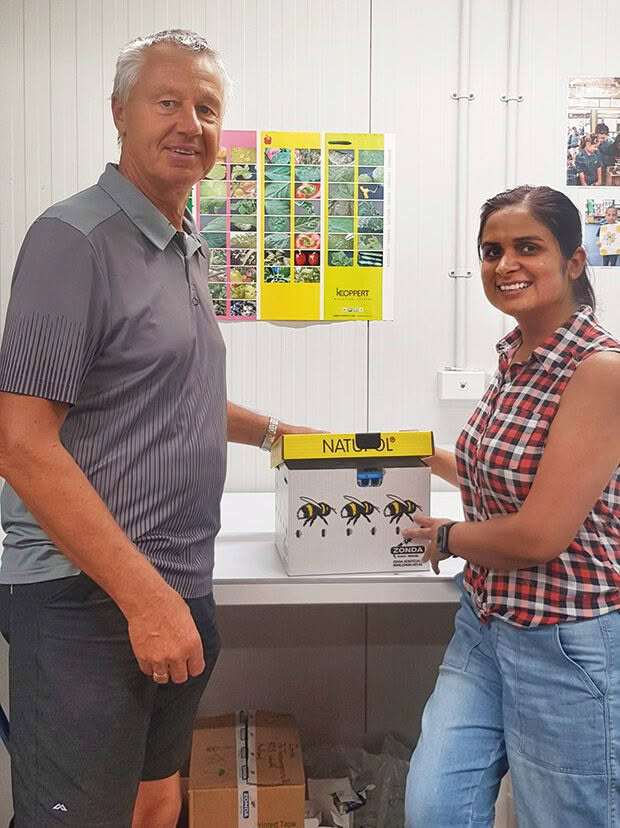This Waiuku business has mastered the delicate art of breeding bumblebees and insect predators

Roelf Schreuder and Gunjan Gera.
Zonda Beneficials provides insect predators for use in horticulture and small-seed production and breeds bumblebees for commercial and domestic pollination.
Words: Kate Coughlan
Mating happens on Thursdays in a side street behind Waiuku, a small town on the Manukau Harbour’s southern shores. Copulating couples are caught, in flagrante delicto, gently seized with long tweezers, which grasp one hairy leg. They are then placed into a plastic box and stored in an insulated, quiet and sterile room lit by a dim red light.
Once their offspring — Bombus terrestris babies — are hatched, they’re fed on rolls of pollen (resembling chipolatas and smelling nicely of beeswax). When ready for work, they are placed in waxed and sealed cardboard cartons and shipped to commercial glasshouses and private gardens throughout the country.
Their job? To go forth and pollinate and, boy, can they pollinate. A bumblebee is 50 times more effective than its svelte cousin, the honeybee (Apis mellifera) which, erroneously, gets most of the credit for pollinating the world’s food crops.

In New Zealand, bumblebees leave honeybees in the dust when it comes to the successful pollination of crops as essential as blueberries, tomatoes, kiwifruit, capsicums, strawberries and raspberries.
A growing number of horticulturists are looking to Zonda Beneficials for the outcome of those Thursday mating sessions by ordering commercial packs of bees for their operations. The bumblebee-breeding work of Zonda Beneficials runs in conjunction with the company’s biological-control business, producing natural predators for use in commercial horticulture.
Spidex, for example, is a small but monstrously efficient predator of the crop-killing two-spotted mite. The nasty two-spotted mite, probably present in most home gardens, wreaks havoc in various commercial crops.
But the Spidex is voraciously hungry and can each eat up to 25 to 35 young two-spotted mites without their presence impacting the food crop. Ah, sounds simple. But the business of breeding these tiny predators is not for the disorganized nor the unskilled. It is complex.

Firstly, it requires a host crop of food to attract the two-spotted mite (beans for example), and once the pest mites are breeding, the introduction of the precious supply of Spidex, which then rapidly eats its fill and multiplies happily.
Perhaps the trickiest of the many processes involved is capturing Spidex. The how of that is a commercial secret. But captured they are, before being shipped off to do their real task in life — devouring two-spotted mite in vast quantities from commercial food crops.
Another Zonda predator mite is Thripex (the trade name for Amblyseius cucumeris). This slightly tear-shaped mite is beige/pink in colour and an active hunter and killer of the eggs and juveniles of western flower thrips and onion thrips, both of which cause damage to commercial food and flower crops.
Elevator pitch: Zonda Beneficials is a 100 per cent subsidiary of NZ Gourmet — one of the country’s largest producers and exporters of tomatoes, capsicums, blueberries, strawberries and cherries. NZ Gourmet is a privately owned company with a 27 per cent investment by the NZ Super Fund.
Who? Dr Gunjan Gera, a plant physiologist and the manager of Zonda Beneficials and Roelf Schreuder, a director of NZ Gourmet who oversees Zonda Beneficials.
Headwinds: “A biological business is always at risk of disease, so we are very careful with hygiene and very rigorous in our systems.” — Gunjan
“The Ministry of Primary Industries is overly cautious about allowing more biological pests into the country. The bureaucracy is not set up to work proactively, but IPM (integrated pest management) requires our government agencies to become more integrated and useful to businesses such as ours.” — Roelf

Tailwinds: “The winds of change are blowing strongly in favour of fewer chemicals in the food supply. Growers are eager to replace spraying as it is expensive, hard and time-consuming. Companies, especially the largest food producers, are eager to find biological control mechanisms and they want them fast.” — Roelf
What’s next? “We are constantly innovating and looking for new predators that can be used safely. A full IPM control requires a range of predators. Unlike using chemical sprays, which tend to kill everything, with the biological control of one pest, another pest will inevitably pop up, requiring a new control solution. We work with the big Dutch IPM expert, Koppert Biological Systems, to try and bring in more predators.” — Roelf
THE NUMBERS
How many staff? 14 Zonda; NZ Gourmet has many hundreds
Annual revenue? $1 million
Annualized growth in the past 3 years? 15% pa
How many clients? 150+ across the domestic and commercial markets
How many different industries does Zonda work in? Horticulture and small-seed production, as well as supplying home gardeners around the country.
MORE HERE
Love this story? Subscribe now!
 This article first appeared in NZ Life & Leisure Magazine.
This article first appeared in NZ Life & Leisure Magazine.
